Related Research Articles
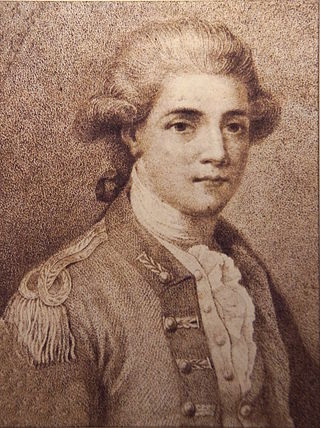
John André was a major in the British Army and head of its Secret Service in America during the American Revolutionary War. He was hanged as a spy by the Continental Army for assisting Benedict Arnold's attempted surrender of the fort at West Point, New York, to the British. André is typically remembered favorably by historians as a man of honor, and several prominent U.S. leaders of the time, including Alexander Hamilton and the Marquis de Lafayette, did not agree with his fate.
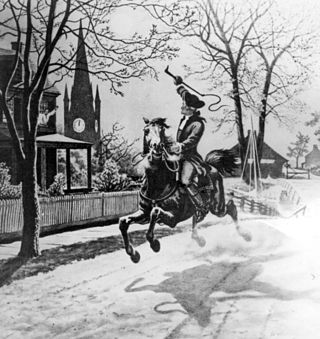
During the American Revolutionary War, the Continental Army and British Army conducted espionage operations against one another to collect military intelligence to inform military operations. In addition, both sides conducted political action, covert action, counterintelligence, deception, and propaganda operations as part of their overall strategies.
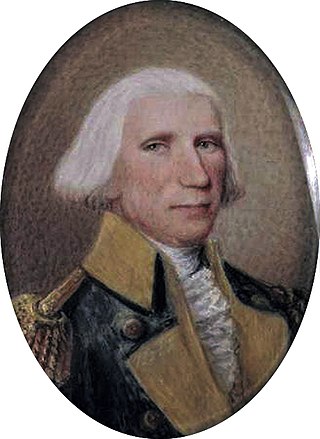
Elias Dayton was an American merchant and military officer who served as captain and colonel of the local militia and in 1783 rose to become a brigadier general during the American Revolutionary War. Afterward, he became the Mayor of Elizabethtown, New Jersey as well as served in the New Jersey General Assembly. He was the father of U.S. Constitution signer Jonathan Dayton.

Benjamin Tallmadge was an American military officer, spymaster, and politician. He is best known for his service as an officer in the Continental Army during the American Revolutionary War. He acted as leader of the Culper Ring during the war, a celebrated network of spies in New York where major British forces were based. He also led a successful raid across Long Island that culminated in the Battle of Fort St. George. After the war, Tallmadge was elected to the US House of Representatives as a member of the Federalist Party.

The Culper Ring was a network of spies active during the American Revolutionary War, organized by Major Benjamin Tallmadge and General George Washington in 1778 during the British occupation of New York City. The name "Culper" was suggested by George Washington and taken from Culpeper County, Virginia. The leaders of the spy ring were Abraham Woodhull and Robert Townsend, using the aliases of "Samuel Culper Sr." and "Samuel Culper Jr.", respectively; Tallmadge was referred to as "John Bolton".
The 2nd Continental Light Dragoons, also known as Sheldon's Horse after Colonel Elisha Sheldon, was commissioned by the Continental Congress on December 12, 1776, and was first mustered at Wethersfield, Connecticut, in March 1777 for service with the Continental Army. The regiment consisted of four troops from Connecticut, one troop each largely from Massachusetts and New Jersey, and two companies of light infantry.
Aaron Van Camp was an espionage agent for the Confederate States of America during the American Civil War. He and his son Eugene B. Van Camp were members of the Rose O'Neal Greenhow Confederate spy ring, which in 1861 was broken up by Allan Pinkerton, head of the newly formed Secret Service.
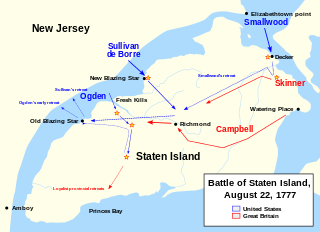
The Battle of Staten Island was a failed raid by Continental Army troops under Major General John Sullivan against British forces on Staten Island on August 22, 1777, during the American Revolutionary War. After British Lieutenant General William Howe sailed with most of his army from New York City in July, Sullivan recognized that the British position on Staten Island was vulnerable, and planned an attack. He carried it out in spite of commanding general George Washington's request that Sullivan reinforce the main army with his troops as soon as possible to support Washington's planned Colonial assault on British-held Philadelphia.

Ann Bates was a loyalist spy during the American Revolution. Originally from Philadelphia, Pennsylvania, Bates was known for her awareness, her intelligence, and her ability to remain calm under pressure. She was commonly referred to as "Mrs. Barnes" by affiliates in her spy networks. She was known to carry an unknown unique token that would eventually identify her as a British spy. She would go on to become a part of British General Clinton's espionage network, and would help the British combat American forces on several fronts. She reportedly took part in various clandestine spy missions between 1778 and 1780. Bates was most well known for her missions completed at George Washington's base camp in White Plains, New York, and during the Rhode Island campaign or the Battle of Rhode Island.
Abraham Woodhull was a leading member of the Culper Spy Ring in New York City and Setauket, New York, during the American Revolutionary War. He used the alias "Samuel Culper", which was a play on Culpeper County, Virginia, and was suggested by George Washington.
355 was the code name of a female spy during the American Revolution, part of the Culper Ring. She was one of the first spies for the United States, but her real identity is unknown. The number 355 could be decrypted from the system the Culper Ring used to mean "lady."

James Moody was a loyalist volunteer during the American Revolution who became a farmer and political figure in Nova Scotia. He represented Annapolis County in the Nova Scotia House of Assembly from 1793 to 1806. He wrote one of the most important loyalist memoires of the war.

Robert Townsend was a member of the Culper Ring during the American Revolution. He operated in New York City with the aliases "Samuel Culper, Jr." and "723" and gathered information as a service to General George Washington. He is one of the least-known operatives in the spy ring and once demanded Abraham Woodhull never to tell his name to anyone, even to Washington.
Caleb Brewster was a member of the Culper spy ring during the American Revolutionary War, reporting to General George Washington through Major Benjamin Tallmadge. He carried messages across Long Island Sound between Major Tallmadge and the ring's main spies on Long Island, New York, and in New York City. He also made direct reports to Washington concerning naval activities in the New York City area.
Anna Smith Strong of Setauket, New York was an American Patriot, and she may have been one of the only female members of the Culper Spy Ring during the American Revolution. Her perceived main contribution in the ring was to relay signals to a courier who ran smuggling and military missions for General George Washington. No information has been found concerning Anna's activities after the war other than that she and her husband, Selah Strong, lived quietly in Setauket for the rest of their lives. She died on August 12, 1812.
Jonas Hawkins was an American Patriot and a member of the Culper Spy Ring during the American Revolution.
Cato Howe was an enslaved African American Black Patriot spy and courier during the American Revolution. Cato's enslaver, Hercules Mulligan, gathered intelligence through his personal connections as well as clients at his New York City tailoring shop, and Cato carried the information on horseback to Continental Army officers and other revolutionaries, including Alexander Hamilton and George Washington, and often through British-held territory. Cato's messages are credited with likely saving Washington's life on two occasions. Other than his intelligence activities with Mulligan, little definite information about Cato is available, though an excavation of his home after the war provides historians with more information about his life after the war.
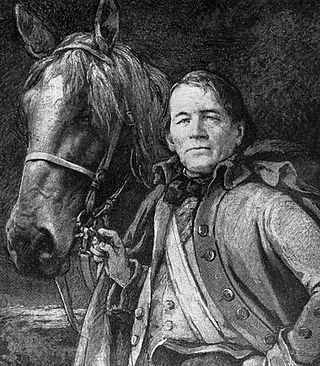
Austin Roe was a member of the Culper Ring, a successful spy network during the American War of Independence that was organized in 1778 by George Washington.
Sarah "Sally" Townsend (c.1760–1842) was thought to be an informant for George Washington's Culper Ring, a spy ring founded in the summer of 1778. Townsend lived in Oyster Bay and passed information to her brother, Robert Townsend, a main member of the ring. She died in December 1842 and is buried at the Townsend Cemetery.
Mersereau is a surname. Notable people with the surname include:
References
- 1 2 3 4 Bakeless, John (1959). Turncoats, Traitors, and Heroes. Philadelphia & New York: Lippincott. p. 179. ISBN 978-0306808432.
- 1 2 3 4 5 Bakeless, John (1959). Turncoats, Traitors, and Heroes. Philadelphia & New York: Lippincott. p. 180. ISBN 978-0306808432.
- 1 2 3 "Maj Joshua Mersereau (1728-1804) - Find A Grave..." www.findagrave.com. Retrieved 2018-03-24.
- ↑ "Founders Online: To George Washington from Joshua Mersereau, 10 June 1789" . Retrieved 2018-03-24.
- ↑ "Founders Online: To George Washington from Joshua Mersereau, 31 August 1778" . Retrieved 2018-03-24.
- 1 2 3 4 5 Harty, Jared (2012). "George Washington: Spymaster and General Who Saved the American Revolution" (PDF). Defense Technical Information Center.[ dead link ]
- 1 2 3 4 5 "John LaGrange Mersereau (1760-1841) - Find A..." www.findagrave.com. Retrieved 2018-03-24.
- ↑ Bakeless, John (1959). Turncoats, Traitors, and Heroes. Philadelphia & New York: Lippincott. p. 364. ISBN 978-0306808432.
- 1 2 Bakeless, John (1959). Turncoats, Traitors, and Heroes. Philadelphia & New York: Lippincott. p. 177. ISBN 978-0306808432.
- 1 2 3 4 Bakeless, John (1959). Turncoats, Traitors, and Heroes. Philadelphia & New York: Lippincott. p. 178. ISBN 978-0306808432.
- ↑ "John Mersereau (1731-1820) - Find A Grave..." www.findagrave.com. Retrieved 2018-03-24.
- ↑ Sulick, Michael (2012). Spying in America. Washington, D.C.: Georgetown University Press. p. 53. ISBN 978-1-58901-926-3.
- ↑ Sulick, Michael (2012). Spying in America. Washington, D.C.: Georgetown University Press. p. 54. ISBN 978-1-58901-926-3.